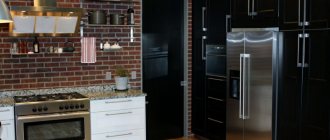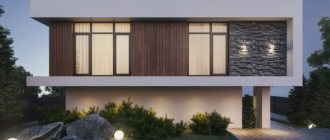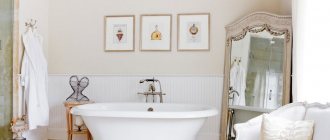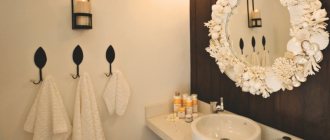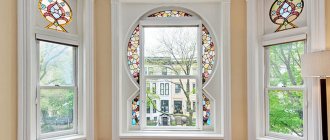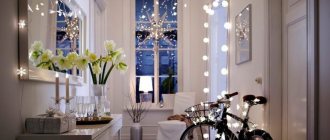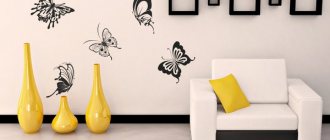There is a mirror in any interior; it is included in the list of the most necessary things in any apartment, house, office and more. Modern design works amaze with their harmony with mirror canvases. To create harmony, special beveled mirrors are used; they transform the atmosphere and are the most in demand.
The word bevel in translation means chamfer or outer edge, a little more clearly, this is a special processing of the edges and outer edge of the glass. The framing occurs at an angle, due to which light is refracted, thus creating an irresistible shine, which is what gives the mirror a more presentable and expensive look.
Important! It is impossible to cut yourself on such a frame, because the sharp edges are smoothed and polished during processing.
There are several types of facet. They differ in the processing method: one-sided and two-sided. When processing edges on both sides, a cut is made on the front and back sides of the canvas, this creates a special radiance of the chamfer.
Features of beveled mirrors
The edges add sophistication to the mirror surface. In a well-lit room, due to refraction, a play of sunlight and room light occurs on the edges of the mirror; it is this ability that attracts and fascinates many. If you place a beveled canvas on the wall, it will visually make the room more spacious. You can create a visualization of additional space simply by placing a mirror product in a niche.
Important! There is no need to place a beveled mirror directly opposite the window; it is better to do it at a certain angle, this will add natural light to the room.
Types of beveled mirrors
Nowadays, beveled mirror glasses are so popular that their variety has exceeded all expectations; the market is simply overflowing with these products. They are:
- Functional;
- For decoration, room decoration;
- Classic options;
- Rectangular;
- Round;
- Unusual shape, non-standard design;
- With or without frame.
Due to the abundance of types, beveled canvas can be chosen to suit every taste and budget.
It is worth noting that the cut can be of two types: straight and curved. By choosing the latter type, you can achieve a very unusual design of the canvas; the extraordinary and curly shapes of the product immediately attract attention.
How beveled mirrors are made
If previously everything was done manually, now it is done using modern software-controlled equipment. Jewelry cutting occurs with a diamond tool; this gentle procedure does not harm the glass and preserves its impeccable appearance. High-tech equipment helps create and achieve levels that will satisfy the whims of the most pampered clients.
How much does a beveled mirror cost?
Beveled processing of the edge of the canvas is expensive due to the complexity of production. The average cost per square meter is from 900 rubles. The cost is affected by the thickness of the framed product; the thicker, the more expensive, from 3,500 rubles and above. If you want to give the canvas an unusual shade, you will have to pay even more. The final cost of such a product consists of the number of all processed edges; if you want more sophistication, you will have to fork out more.
Facet on the mirror
Beveled mirror: the highlight of room design
The bevel created on the mirror gives it sophistication, giving rise to thousands of reflections. The use of this technology by our specialists allows us to realize any design ideas.
Types of facet
Bevelling is a method of processing a mirror or glass, which consists of cutting off part of the surface at a certain angle. Thanks to this, a magnificent visual effect is achieved. The process is not simple; in past years it took a huge amount of time from craftsmen and required certain qualifications.
Today, thanks to technological advances, everything has become simpler, and our company’s specialists have new opportunities. Now we are ready to create a bevel quickly, delighting those who so like “embossed” mirrors in the interior. Beveled reflective panels add a sophisticated shine to any room. The mirror becomes three-dimensional, organically fitting into the design of the home.
When processing mirrors, two types of bevels can be distinguished: rectilinear and curved.
- Straight-line is used for products that have “rigid” shapes: rectangle, square, etc. In this case, the presence of rounded elements is simply impossible. Such bevelling is often used, for example, in the manufacture of widely sought-after mirror tiles.
- Curvilinear type involves processing curved edges or smooth shapes. There is room for the design idea to expand here - waves, ovals, as well as other “curves” can be beveled in this way. Such finishing elements for kitchens, hallways, etc. will definitely attract the attention of others.
Depending on the customer’s requirements, the size of the bevel created by our specialists can range from 5 to 45 mm. It should be noted that this choice affects the appearance of the product, and therefore treat it extremely carefully. Mirrors with a thickness of 4, 5 or 6 mm are quite suitable for creating a chamfer.
Where is it used?
Bevelling of mirrors is used in the production of mirror panels, which can often be seen in various rooms. They can perfectly replace traditional ceramic tiles, being the main design touch when creating interiors. Such compositions can be found:
- - in kitchens;
- — in bathrooms, bedrooms and corridors;
- - in conference rooms and sports facilities.
Also, mosaic panels decorate wardrobes, cabinets and other pieces of furniture.
The presence of a facet “revitalizes” the panel, causing the sun’s rays to play on the edges or reflecting the light of chandeliers. The room is visually enlarged and filled with light. The edges play with all the colors of the rainbow, making an ordinary mirror look like jewelry.
The facet of the mirror allows you to achieve the effect desired by many designers. Our company is ready to offer similar processing of mirrors - you can order bevelling from us inexpensively, it will be done carefully and on time. Even a small dark corridor, decorated using a mirror panel, will look like a spacious hall, filled with light and seemingly increased in size.
At the same time, mirror tiles with chamfers do not require any special care - you should take care of them in the same way as a “regular” mirror.
Types of mirrors
Before you buy a mirror, you need to think about how organically it will fit into your existing interior. Each of them has its own “character”, capable of emphasizing certain details available in the room. To do this, there are a number of technologies that allow you to give the mirror a certain appearance. For example, sometimes the so-called “aging” makes sense, that is, giving the mirror a noble appearance – “like from past centuries.”
Depending on the client’s requirements, such a surface can have certain shades: silver, bronze, gray. The presence of a bevel on such surfaces will only emphasize the beauty of the chosen mirror, forcing those present in the room to pay attention to it.
We have been working in this field for a long time and have sufficient experience and the necessary equipment for beveling mirrors. When you contact us, the price of the service will not be high, but the effect produced is very, very impressive.
How to choose the right falsetto mirror
First of all, focus on the design of the room, a mirror with a falsetto is an object with a twist; it will not look in a small, drab room. Please pay attention to the following points if you still decide to buy canvas:
- The most important aspect, the quality of the glass, it must be of the highest quality;
- Then the thickness of the canvas, it should not be too thin, otherwise its quality will suffer;
- There should be no scratches, dents, chips, or abrasions on the surface of the product;
- The back side of the mirror must be treated with a special material, thanks to which it will be protected;
- High-quality edge, an indicator of strength and long service life of the product.
You can buy a beveled mirror either ready-made or order it to be made according to a special drawing, or experienced employees can make a drawing for your individual order.
How to recognize such a mirror
A mirror canvas with this design looks complete, you don’t need to add anything to it, it is unique in itself. The size of the frame is usually 4.5 cm. If you make a large bevel, the product may crumble over time. The processed edges of the edge should be perfect, and the edge itself should be even and smooth. The front side must be processed and polished. If the framing is not done correctly, the reflective light will not seem so elegant. Since the cutting takes place at different angles, this gives the glass a dazzling shine.
Cost of curved bevel
| Bevel width | Price RUR/m.p. | |||
| 4-6 mm | 8-10 mm | 12 mm | 15 mm | |
| 10 mm | 840 | 880 | 920 | 1000 |
| 15 mm | 920 | 960 | 1000 | 1040 |
| 20 mm | 1100 | 1180 | 1280 | 1300 |
| > 20 mm | 1200 | 1300 | 1600 | 1720 |
Beveled mirrors look great in any interior. They visually expand the space and, when placed opposite windows or lighting fixtures, make the room brighter. Fans of original solutions should pay attention to stained glass windows made from beveled mirrors, mirrors of unusual shapes (in the form of a flower, sun, cloud, animal figure). The classic interior will be complemented by products with frames made of different materials. Sliding wardrobes with doors made of mirrors with cut edges are very popular today. Moreover, the latter can be either solid - diamond engraving is used, or consisting of individual elements - mirror tiles.
Pros and cons of coverage
A beveled coating has a huge advantage; it can turn ordinary glass or a mirror into a stylish decorative element. Such a mirror will make the room brighter, expand the space in it and will attract all eyes. In order for it to fit perfectly into the room, the mirror must be made to the required dimensions, and also fit correctly into the decor of the room.
The main disadvantage is the price and constant and additional care; wiping a beveled mirror with a regular wet cloth is not always effective and correct; it is better to use special cleaning products. Of course, these disadvantages are not so terrible compared to the beauty and advantage of a beveled mirror.
Important! It is better not to skimp when choosing a beveled mirror, unless of course you want to get a high-quality and long-lasting product. Therefore, think carefully before purchasing.
Bevel types: processing features
There are several types of bevels, which allows you to choose the best option for each product:
- One-sided beveling is the simplest and most common type of processing. It is a side edge, beveled on one side.
- Double-sided bevel – processing of a glass surface on both sides. This technique is used to give the frame greater expressiveness, brightness and brilliant shine.
- Double bevel – also used to enhance the effect. This cut consists of two strips: a wide one and a narrower one. And they reflect light twice as much, making the product look like a precious piece of jewelry.
- Curvilinear bevel – used for processing products in the following shapes: oval, circle, arch, wave and other products with a figured contour.
A straight bevel is used for processing workpieces with smooth edges: square, rhombus, rectangle, etc. That is, in products without rounded corners.
Beveled glass
Bevelling allows you to turn ordinary glass into a stylish element of your decor, giving it individuality and emphasizing the chosen interior style. Brightly shining edges enliven even the most ordinary thing and create an unusual play of light. In order to enhance this effect, you can use different brands of glass, for example combining clear or frosted glass or glass with a mirror reflection (AGC “Stopsol”).
Glass with cut edges looks great in interior doors, cabinet doors, and is used to create coffee tables and all kinds of shelves. Thus, the atmosphere gives a feeling of lightness and the furniture does not cause a feeling of clutter, freeing up maximum space in the house.
Mirror with bevel
Decorating mirrors using bevels is an effective way to get a luxurious item. This is especially important if the mirror performs not only a practical, but also an aesthetic function, visually changing the space of the room and hiding minor imperfections in the furnishings.
Beveled mirrors can be used as independent decorative elements or used to create mirror compositions: panels, mosaics, tiles. They allow you to place a winning emphasis on the merits of the interior, make the room lighter and more spacious, and simply play up this or that piece of furniture in an original way.
Is it worth buying a beveled mirror?
Modern technologies do an excellent job of producing beveled mirrors; they come out with perfect bevels and polishing. A high-quality product is strong and therefore durable. The appearance of such a product will decorate the interior of the room for a long time, and if you place it in a metal or wooden frame, or a baguette, it will fascinate with its beauty. When choosing decorative elements, beveled mirror canvas has a great advantage; it is original and eye-catching. There is a mirror in every home, but it’s up to you to decide what it will be, regular or beveled.
Why are facets needed?
At first it may seem that bevelling of mirrors has an exclusively decorative function. In fact, this is not entirely true. In addition to the decorative purpose, bevels on mirrors perform the following functions:
- Increasing the strength of the canvas. Bevelling eliminates mechanical defects, irregularities and chips, which not so rarely appear at certain stages of glass or mirror manufacturing.
- Increased operational safety. Bevel is the smoothing of sharp edges with further polishing of the edge. Due to this, the risk of injury and the possibility of cutting yourself on the edge of the canvas becomes almost impossible.
Bevelling is carried out using special grinding machines that process the surface of the mirror cloth with maximum accuracy and precision. Thanks to this, the procedure does not have any negative impact on the characteristics of the canvas, including its appearance.
